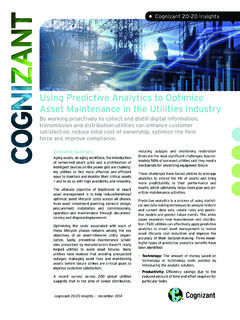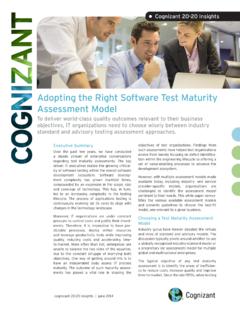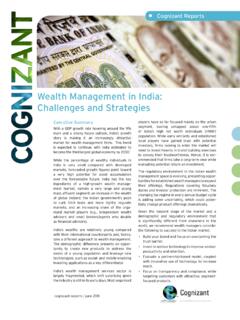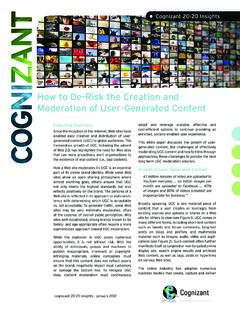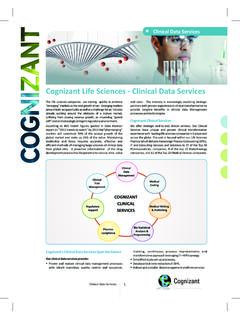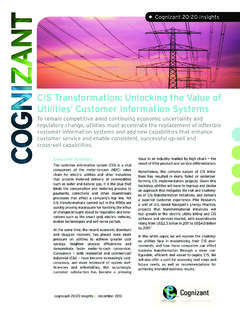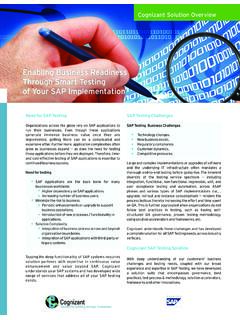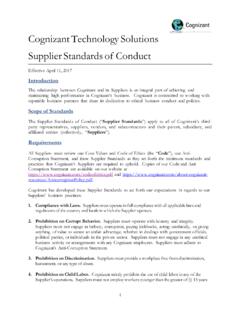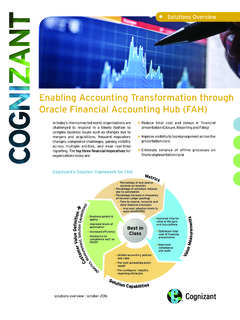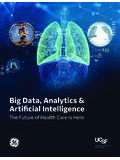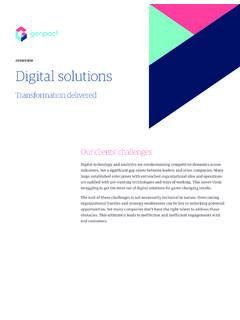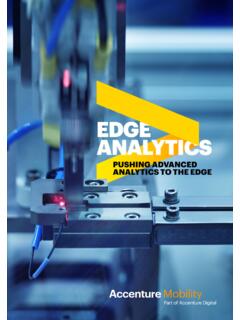Transcription of COGNIZANT 20-20 INSIGHTS
1 Applying predictive analytics to Deliver Smart Power Outage CommunicationsBy building proactive outage communication that provides accurate, detailed and real-time outage statuses through customers preferred channels, power utilities can improve overall customer experience, customer satisfaction and operational efficiency. COGNIZANT 20-20 INSIGHTS | November 2017 COGNIZANT 20-20 INSIGHTSC ognizant 20-20 InsightsApplying predictive analytics to Deliver Smart Power Outage Communications | 2 Executive SummaryToday s energy utility customer is likely a user of Amazon, UPS and Uber, and has similar high experience expectations especially before, during and after power outages. This means utilities must understand and address a wide array of customer concerns, including: What: providing the most up-to-date outage information.
2 When: delivering updates in real-time. How: using channels such as social media, phone calls, SMS and e-mail. Where: managing crew status and response. Why: understanding the root cause of an outage. Doing this requires energy utilities to overcome two major hurdles: One, how can they be early, accurate, proactive and detailed in communi-cating the power outages to their customers? Second, how effectively can they manage mul-tiple information constraints simultaneously? Power outages can result both from unplanned reasons (weather, equipment malfunctions, third-party actions like digging mishaps, car-pole accidents or vandalism etc.) and from planned reasons such as maintenance, so dif-ferent communication channels are needed.
3 Communicating an electrical power outage effectively during these cases in our view is hypercritical for overall customer energy utilities are upgrading their exist-ing outage management ecosystem to improve outage communications. However, utilities face some major hurdles, including: The lack of an automated and intelligent platform to collect and process all outage inputs. Severe limitations of legacy outage man-agement system (OMS) to filter all outage inputs. No single source of data to store historical and current/forecasted data. No intelligence mechanism for determining which customers are affected by outages. Inaccurate outage messages sent to on our experience working with many leading energy utilities on similar initiatives, the above hurdles can be addressed with a smart outage communication ecosystem, one that is is machine-learning-enabled.
4 We recommend that energy utilities build this envi-ronment holistically and use advanced digital tools that comprise three stages/sub-ecosys-tems: upstream, midstream and downstream components. This model would definitely help utilities during emergencies or outages caused by natural disasters such as hurricanes by effectively providing the most up-to-date infor-mation to customers. Many energy utilities are upgrading their existing outage management ecosystem to improve outage communications. Applying predictive analytics to Deliver Smart Power Outage Communications | 3 HISTORICAL CONTEXTFrom the dawn of electricity, utility custom-ers were typically left in the dark concerning the cause of an outage or when power will be restored.
5 Traditionally, customers needed to be proactive and communicate with the utility service provider to learn when the lights would come back on. That s the way utilities operated; customers were conditioned to expect little in the way of communication from their power , in today s age of information and social media, customers expect much more from their utility provider. Utilities are trying to keep pace with the changing times to provide customers with up-to-date outage illustrated in Figure 1, 75% of utility companies are providing outage alerts to their customers. Even though this is encouraging, these alerts have limitations: Utilities are often unable to identify which customers have lost power. For example, in the case of a feeder outage, not all custom-ers would be affected but alerts may be sent to customers who still have power.
6 This leads to confusion and frequent calls to the utility s customer service department. Alerts may be based only on the ticket status of reported outages. For example, alerts such as crew status, outage causes, etc. (see Figure 2, next page) are rarely sent. Customers do not receive real-time outage alerts. For instance, some customers may have had their power restored due to auto-matic feeder switching, but the outage restoration alert is provided to them only when the outage ticket is actually today s age of information and social media, customers expect much more from their utility provider. Outage Communications Industry Survey33% 38% 12% 21% 45% 75% 2014 (n=52) 2015 (n=47) Portion of utilities offering a preference portal that allows customers to manage alerts across various channels.
7 Portion of utilities offering customers two-way texting for outage communications, including the option for customers to notify the utility about their outage by text message. Portion of utilities providing proactive outage alerts to customers. Source: Chartwell s Outage Communications Industry Survey Figure 1 COGNIZANT 20-20 InsightsApplying predictive analytics to Deliver Smart Power Outage Communications | 4To communicate in real time to customers, utility providers must integrate their OMS with the dis-tribution management system (DMS), advanced metering infrastructure (AMI), supervisory con-trol and data acquisition (SCADA) and the work management system (WMS). Utility companies progress in developing such OMS capabilities is shown in Figure 3, next STATE LIMITATIONSC ustomers who experience a power outage cur-rently have two options for reporting it to the utility provider: Calling customer service.
8 Via online communication (mobile applica-tion/utility website).If the customer calls to report the outage, he can speak with a customer service representative, who will in turn create a ticket in the OMS. The customer can also choose to interact with the voice response unit (VRU) to submit the relevant outage information. Similarly, information can also be provided on the company s mobile application or website (if the utility provider offers such support). Once the information is collected, by any of the above methods, an outage ticket is generated in the OMS. The customer will be provided with the ticket number, as well as an estimated time of restoration. Some utility companies offer cus-tomers the option to receive updates during the restoration process.
9 Customers must provide a contact number where they can be reached with the outage update information. When Outage Communications Occur14% 17% 20% 20% 40% 60% 60% When crew status is updatedWhen the outage cause is establishedWhen an outage is reported by the customerWhen the outage cause is updatedWhen an outage is first verified by systemsWhen the estimated restoration time (ERT) is updatedWhen the power is thought to be restoredSource: Chartwell s Outage Communications Industry Survey, n=47 Figure 2To communicate in real time to customers, utility providers must integrate their OMS with the distribution management system, advanced metering infrastructure, SCADA and the work management 20-20 InsightsApplying predictive analytics to Deliver Smart Power Outage Communications | 5 Major drawbacks of the current approach include.
10 Inability to proactively communicate the outage updates to the affected customers. The lack of real-time situational awareness and visibility for accurately determining the affected customers. The lack of integration among OMS, AMI and SCADA systems, and inefficiencies caused by the inability to seamlessly transition from a legacy communication system to new digital A SMART POWER OUTAGE COMMUNICATION ECOSYSTEMA smart power outage communication ecosystem should be able to resolve the following business cases: Case 1: Predict the impact of special weather events on the power grid and customers. Case 2: Predict the impact of near-term asset failures on the power grid and customers. Case 3: Detect possible outages based on smart meter events.
